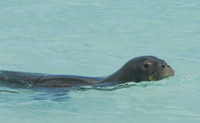Papahanaumokuakea Marine National Monument Considered For World Heritage Site Designation
March 21, 2008
Secretary of Interior Dirk Kempthorne has announced that the crown jewel of NOAA's National Marine Sanctuary System, Papahanaumokuakea Marine National Monument, is one of two sites he is considering to officially nominate for inclusion on the UNESCO World Heritage List. Also up for nomination is George Washington's Virginia home, Mount Vernon. The nominations are the first by the United States to the global treasure list since 1987 and will, if ratified by the international World Heritage panel, become the 21st and 22nd U.S. World Heritage sites.
The notice opens a 15-day public comment period regarding the nomination proposals. Comments can be made by email to: Jonathan Putnam, Office of International Affairs, National Park Service at jonnathan_putnam@nps.gov.

Northwestern Hawaiian Islands monk seal.
+ High Resolution (Credit: NOAA)
"NOAA is delighted and honored by Secretary Kempthorne’s decision to include Papahanaumokuakea Marine National Monument as one of two distinguished and deserving United States nominees to the World Heritage list, " said retired Navy Vice Adm. Conrad C. Lautenbacher, Ph.D., under secretary of commerce for oceans and atmosphere and NOAA administrator. "When President Bush set aside this unique marine environmental ecosystem as the world's largest marine protected area in June 2006 it was in recognition of the value of preserving one of the nation's largest remaining pristine natural areas. This designation will add to that distinction."
Papahanaumokuakea is nominated for both its cultural and natural resources. Native Hawaiians view the Northwestern Hawaiian Islands as an integral part of the archipelago and as a deeply spiritual location. Physical remnants of wahi kūpuna (ancestral places), and oral and written accounts provide evidence of the various past uses of the islands and surrounding ocean by Native Hawaiians both as a home and a place of worship.
The Monument contains one of the world’s most significant marine and terrestrial ecosystems, representing a major stage of the earth’s evolutionary history, an outstanding example of significant on-going geological processes, and significant habitats where rare and endangered plant and animal species still survive. It is home to more than 7,000 marine species, a quarter of which are found nowhere else on Earth, and includes nearly pristine coral reefs, the largest nesting albatross colony in the world, and the primary habitat for critically endangered Hawaiian monk seals and threatened green turtles.
Papahanaumokuakea Marine National Monument is managed jointly by three co-trustees — the Department of Commerce, Department of the Interior, and the State of Hawai‘i — and represents a cooperative conservation approach to protecting the entire ecosystem. The Monument area includes the Northwestern Hawaiian Islands Coral Reef Ecosystem Reserve, Midway Atoll National Wildlife Refuge/Battle of Midway National Memorial, Hawaiian Islands National Wildlife Refuge, Kure Atoll Wildlife Sanctuary, and Northwestern Hawaiian Islands State Marine Refuge.
As part of the global campaign to raise awareness about the value and importance of the coral reefs and threats to their sustainability, 2008 has been dedicated as the International Year of the Reef. Join Papahanaumokuakea in this worldwide celebration and learn more on how to care about your coral reefs at the International Year of the Reef - Hawai'i Web site. For additional information on the Monument, please visit the Web site.
The National Oceanic and Atmospheric Administration, an agency of the U.S. Commerce Department, is dedicated to enhancing economic security and national safety through the prediction and research of weather and climate-related events and information service delivery for transportation, and by providing environmental stewardship of our nation's coastal and marine resources. Through the emerging Global Earth Observation System of Systems (GEOSS), NOAA is working with its federal partners, more than 70 countries and the European Commission to develop a global monitoring network that is as integrated as the planet it observes, predicts and protects.
